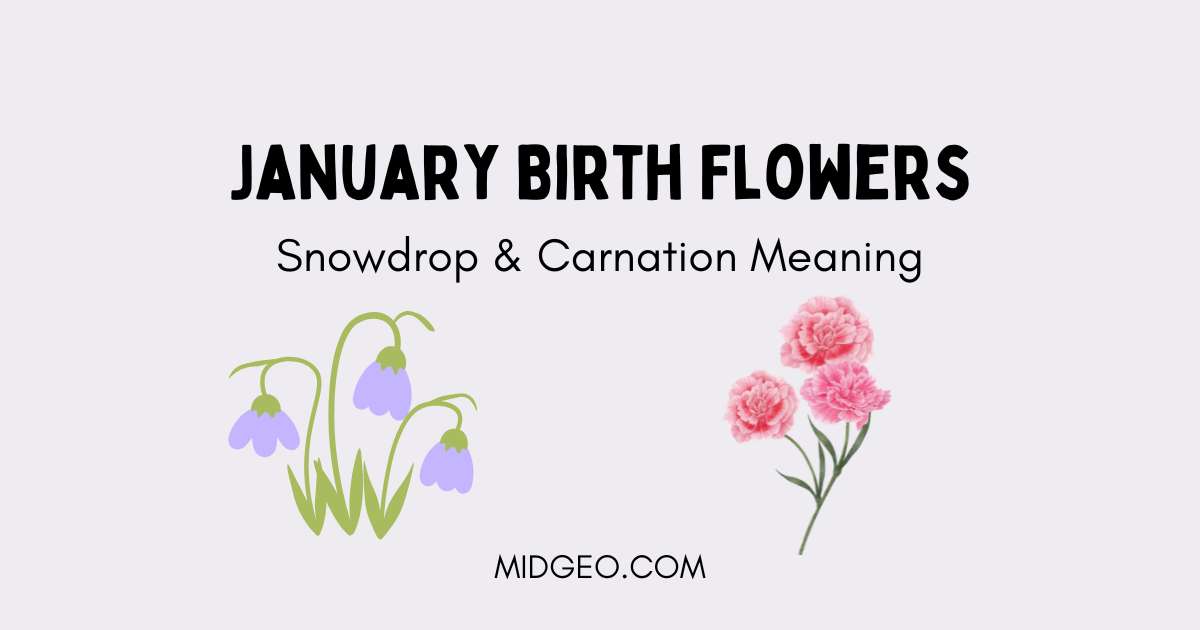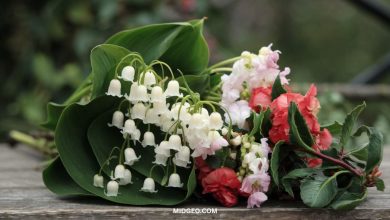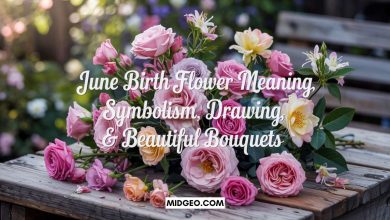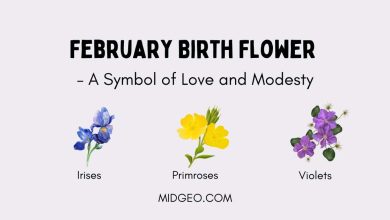January Birth Flowers: Snowdrop & Carnation Meaning

January marks the beginning of a new year, a time filled with hope, fresh starts, and aspirations. Reflecting these themes are January’s birth flowers—the delicate Snowdrop and the vibrant Carnation.
These blossoms not only captivate with their beauty but also carry rich symbolism that resonates deeply with the spirit of the month.
The Snowdrop, with its pristine white petals, symbolizes purity and new beginnings, emerging as one of the first flowers to bloom in winter’s chill.
Related: February Birth Flower – A Symbol of Love and Modesty
On the other hand, the Carnation, known for its ruffled petals and a spectrum of colors, represents love, admiration, and distinction.
Together, these flowers embody the essence of January: resilience, renewal, and affection.
This article delves into the enchanting world of January’s birth flowers, exploring their meanings, historical significance, and creative uses, while celebrating their enduring charm.
What Is the January Birth Flower?
January, with its frosty charm, is represented by two distinct yet equally beautiful flowers: the Snowdrop and the Carnation. Each of these blooms carries a unique meaning and rich historical significance, making them perfect symbols for this month of fresh beginnings.
Meaning and Historical Background
The Snowdrop is often considered a symbol of hope and renewal. Its delicate white petals pushing through the frozen ground have long been associated with purity and the promise of brighter days ahead.
Historically, the Snowdrop has been linked to Victorian traditions, where flowers conveyed emotions and messages in the “language of flowers.”
It was seen as a comforting emblem during harsh winters, reminding people of resilience and perseverance.
The Carnation, in contrast, is vibrant and versatile, symbolizing love, fascination, and distinction. Originating in the Mediterranean region, carnations were cherished by ancient Greeks and Romans, who used them in ceremonial garlands.
Over centuries, this flower became a favorite in celebrations and expressions of deep feelings, from admiration to devotion.
See Also: Funny & Short Hibiscus Flower Quotes to Inspire Your Instagram Feed
Why January Has Two Birth Flowers?
Having two birth flowers allows for a broader representation of January’s characteristics. The Snowdrop captures the quiet resilience and purity of the winter season, while the Carnation reflects warmth and the enduring spirit of love and connection, even during cold and challenging times.
This dual representation ensures that the month’s essence is captured in its entirety—both the stark beauty of winter and the lively emotions that bring people together.
Related: Cute, And Short Flower Quotes to Brighten Your Day
The Snowdrop: January’s Iconic Birth Flower
What Is a Snowdrop?
The Snowdrop (Galanthus) is a dainty white flower known for its graceful, drooping blooms that appear during the coldest months of the year.
Native to Europe and the Middle East, this resilient plant is one of the first to emerge from the frosty ground, signaling the transition from winter to spring.
With its bell-shaped flowers and slender green leaves, the Snowdrop is a true marvel of nature, thriving in harsh conditions and bringing hope to a barren landscape.
The Symbolism of the Snowdrop
Hope and New Beginnings
The Snowdrop has long been a symbol of hope and renewal, embodying the promise of brighter days ahead. Its ability to bloom in the depths of winter serves as a reminder that even in life’s most challenging times, new opportunities await.
The flower’s pure white petals also represent innocence and purity, further enhancing its reputation as a harbinger of fresh starts.
In the language of flowers, the Snowdrop conveys messages of optimism and encouragement, making it a meaningful gift for someone embarking on a new journey or overcoming adversity.
Related: Famous And Motivational Short Flower Quotes
Historical and Cultural Significance
The Snowdrop holds a special place in history and culture, often associated with folklore and traditions. In Victorian times, the Snowdrop was a cherished emblem of sympathy and comfort.
It was often planted near homes and graveyards, believed to protect against misfortune and bring peace to the departed.
In some European legends, the Snowdrop is linked to the story of Adam and Eve, representing hope after their expulsion from Eden.
According to the tale, when Eve despaired in the cold, an angel transformed falling snowflakes into Snowdrop flowers, offering her solace and the promise of spring.
Today, Snowdrops are celebrated worldwide as a symbol of resilience and renewal, often appearing in festivals and gardens that honor the beauty of winter blooms.
Carnation: A January Favorite
What Is a Carnation?
The Carnation (Dianthus caryophyllus) is a timeless flower known for its ruffled petals and vibrant hues. Native to the Mediterranean, this hardy bloom has been cultivated for centuries for its beauty and versatility.
Carnations are often found in a wide range of colors, each carrying its own unique meaning, making them a favorite in floral arrangements, celebrations, and expressions of affection.
With their long-lasting blooms and sweet, subtle fragrance, carnations are a popular choice for events and gifts, symbolizing heartfelt emotions and cherished bonds.
See Also: 130 Best Flower Captions For Instagram: Short, Funny, and Quotes to Blossom Your Feed!
The Symbolism of Carnations
Love and Admiration
Carnations are rich in symbolism, often associated with love, admiration, and gratitude. The flower’s meaning varies by color:
- Red carnations represent deep love and affection.
- Pink carnations symbolize motherly love and gratitude.
- White carnations signify purity and luck.
- Yellow carnations convey cheerfulness or, in some contexts, disappointment.
- Purple carnations can symbolize capriciousness.
This versatility makes carnations an ideal choice for expressing a range of sentiments, from romantic gestures to tokens of appreciation for friends and family.
- June Birth Flower Meaning Symbolism, Drawing & Beautiful Bouquets
- May Birth Flower: Meaning, Symbolism & Beautiful Bouquets
- April Birth Flower: Meaning, Symbolism & Beautiful Bouquets
- February Birth Flower – A Symbol of Love and Modesty
- January Birth Flowers: Snowdrop & Carnation Meaning
Historical and Cultural Significance
Carnations have played a significant role in history and culture, dating back to ancient Greece and Rome. The name “Dianthus” is derived from Greek words meaning “flower of the gods,” highlighting its revered status.
Romans used carnations in ceremonial crowns and garlands, celebrating their beauty and divine connection.
During the Victorian era, carnations became a central part of the “language of flowers,” where their colors communicated specific messages.
For instance, a pink carnation expressed gratitude, while a red carnation symbolized admiration and passion.
In modern times, carnations remain a popular choice for celebrations such as Mother’s Day, weddings, and anniversaries.
Their affordability, beauty, and long-lasting blooms make them a favorite among florists and flower enthusiasts alike.
From their rich historical roots to their enduring symbolism, carnations continue to brighten January with their charm and significance, earning their place as one of the month’s beloved birth flowers.
How to Use January Birth Flowers
Decorating with Snowdrops and Carnations
Incorporating January birth flowers into your décor is a wonderful way to embrace the spirit of the season.
- Snowdrops can add a touch of elegance to your home. Place them in simple glass vases to highlight their delicate beauty or combine them with evergreen foliage for a wintry centerpiece. Their soft, understated charm complements minimalist and rustic styles alike.
- Carnations are ideal for adding pops of color to your space. Arrange them in bouquets with complementary blooms or use them as single stems in narrow-necked vases for a more modern look. Thanks to their long-lasting nature, carnations are perfect for brightening up living rooms, dining tables, or even workspaces during January’s gloomy days.
For special occasions, combining snowdrops and carnations in floral arrangements creates a unique blend of purity and warmth that celebrates January’s essence.
Gifting Ideas
Birth flowers make thoughtful and meaningful gifts, especially for those celebrating January birthdays or milestones.
- A bouquet of carnations, personalized with the recipient’s favorite colors, conveys heartfelt emotions like love, admiration, or gratitude.
- Snowdrop bulbs packaged in a pretty pot make a unique gift that blooms year after year, symbolizing renewal and resilience.
- Combine the two flowers in a bespoke floral arrangement for an extra-special touch.
Pair these flowers with a handwritten note explaining their meanings to make the gift even more memorable.
Drawing January Birth Flowers
Artistic Inspiration from Snowdrops and Carnations
Snowdrops and carnations have captivated artists for centuries with their unique forms and intricate details.
- Snowdrops inspire simplicity with their soft white petals and graceful arch. They often symbolize minimalism and serenity, making them perfect subjects for delicate line art or watercolors.
- Carnations, with their ruffled petals and vibrant colors, lend themselves beautifully to bold, expressive artworks. Their layered texture is a great challenge for artists looking to refine their skills.
Whether you prefer sketching, painting, or digital art, these flowers provide endless inspiration for capturing nature’s beauty.
Step-by-Step Drawing Tips
To create your own drawings of January birth flowers, follow these simple steps:
- Start with basic shapes. Use ovals and circles to outline the flower heads and stems.
- Add petals. For snowdrops, sketch elongated, teardrop-shaped petals. For carnations, focus on drawing ruffled, overlapping petals.
- Refine the details. Add texture to the petals by drawing fine lines or shading. Pay attention to the curvature of the petals to create a realistic look.
- Draw the stems and leaves. Snowdrop stems are slender and arching, while carnation stems are slightly thicker and more upright. Don’t forget the long, narrow leaves!
- Enhance with color. Use soft whites and greens for snowdrops, and vibrant reds, pinks, or purples for carnations.
Drawing these flowers is a relaxing and rewarding activity that allows you to connect with the beauty of nature while developing your artistic skills.
SeeAlso: 125 Rose Captions and Quotes for Instagram
January Birth Flower Meaning
A Deeper Dive into Symbolism
The January birth flowers, Snowdrop and Carnation, each carry profound symbolism that resonates with the themes of the month.
- Snowdrops are often associated with hope, new beginnings, and purity. These delicate blooms thrive in the cold, breaking through frosty ground to signal the promise of spring. Their resilience and grace inspire optimism, making them a perfect emblem of renewal.
- Carnations, with their vibrant colors and ruffled petals, represent love, admiration, and distinction. Their wide range of meanings—spanning gratitude, passion, and even luck—makes them a versatile flower for expressing various sentiments.
Together, these flowers capture the essence of January: a time of fresh starts, resilience, and heartfelt emotions.
Connection to Astrology and Personality
January’s birth flowers align beautifully with the traits of Capricorn (December 22 – January 19) and Aquarius (January 20 – February 18).
- Capricorn, known for its discipline and perseverance, mirrors the resilience of snowdrops, which bloom despite harsh conditions.
- Aquarius, celebrated for its creativity and individuality, reflects the colorful diversity of carnations, each hue representing a unique emotion or trait.
If you were born in January, these flowers symbolize your ability to inspire others with your strength and heartfelt connections.
Fun Facts About January Birth Flowers
Rare Varieties and Unique Features
Both the snowdrop and carnation boast fascinating characteristics that make them stand out:
Snowdrop Fun Facts:
- Snowdrops are one of the first flowers to bloom in the new year, often peeking through snow-covered ground.
- They are sometimes referred to as “milk flowers” due to their pure white petals.
- Certain species, like the Galanthus elwesii, feature unique green markings on their petals, adding an extra touch of beauty.
Carnation Fun Facts:
- Carnations are edible! They’re often used to decorate cakes and desserts or infused in teas for a subtle flavor.
- Some carnation varieties, like the “Chabaud” and “Giant Ruffled,” are prized for their extraordinary petal shapes and vibrant hues.
- Carnations are long-lasting cut flowers, often staying fresh for up to three weeks with proper care.
These fun facts highlight the charm and distinctiveness of January’s birth flowers, making them even more special for those celebrating a January birthday.
Snowdrop and Carnation in Modern Culture
Appearances in Literature, Art, and Media
Snowdrops and carnations have long held a special place in the creative world, appearing in various forms of art, literature, and media:
Snowdrops in Literature and Art:
- Snowdrops often symbolize hope and renewal in poetry and prose. William Wordsworth’s nature-inspired works capture the quiet elegance of this bloom, likening its appearance to whispers of spring.
- Artists frequently use snowdrops as a motif in still-life paintings to evoke serenity and purity. The flower’s delicate form and cool white tones are ideal for minimalist compositions.
Carnations in Popular Culture:
- Carnations are symbolic in many cultures and are frequently referenced in historical literature. In Victorian times, they were key in the “language of flowers,” where their colors conveyed specific messages.
- Carnations often appear in films and television shows as symbols of love or celebration, such as being used in wedding bouquets or as lapel flowers during formal events.
In contemporary media, both flowers are beloved for their timeless beauty and emotional resonance, often featured in advertisements and greeting cards celebrating January birthdays.
January Birth Flower Outline
How to Sketch and Outline for Creative Projects
Creating artistic outlines of snowdrops and carnations can be a fulfilling way to honor their beauty. Follow these tips for your creative projects:
- Gather Your Tools
- Use a pencil with a soft lead for light sketches. A fine-tip pen or marker can be used to finalize the outline.
- Reference clear images of snowdrops and carnations for accuracy.
- Sketching Snowdrops
- Start by drawing a slender, arching stem.
- Add an oval at the top to represent the flower’s bud.
- Sketch three elongated, teardrop-shaped petals that hang downwards, leaving a small gap between them for realism.
- Draw narrow leaves extending from the base of the stem.
- Outlining Carnations
- Begin with a circle to map the bloom’s general shape.
- Create ruffled, wavy lines around the circle for the layered petals.
- Add a thicker, straight stem with a few narrow leaves along its length.
- Add Details
- For snowdrops, add gentle shading to the petals and green accents to the markings near the stem.
- For carnations, emphasize the texture of the petals with fine lines and add depth by shading where petals overlap.
- Refinement
- Once satisfied with the pencil sketch, go over the outline with ink or marker. Erase unnecessary lines to keep the drawing clean.
These outlines can be used for greeting cards, tattoo designs, or as a guide for painting projects, making the January birth flowers a versatile source of artistic inspiration.
Final Thoughts,
The enduring charm of January birth flowers lies in their ability to symbolize hope, love, and resilience. Snowdrops, with their delicate petals breaking through the frost, remind us of renewal and perseverance. Carnations, vibrant and diverse, convey deep emotions of admiration and affection. Together, they offer a perfect representation of January’s spirit—a month of fresh beginnings and heartfelt connections.
Whether used in decorations, gifts, or art, snowdrops and carnations continue to inspire and bring beauty into our lives, making them timeless symbols for anyone born in this special month.
FAQs
1. What are the January birth flowers?
The January birth flowers are Snowdrops and Carnations. These blooms represent hope, renewal, love, and admiration, capturing the essence of the winter season.
2. What do snowdrops symbolize?
Snowdrops symbolize hope, purity, and new beginnings. They are often seen as a sign of spring’s approach, breaking through the cold winter ground with their elegant white petals.
3. What do carnations represent?
Carnations symbolize love, admiration, and distinction. Different colors of carnations carry specific meanings, such as red for love, pink for gratitude, and white for purity.
4. Are there specific colors for January birth flowers?
Yes, specific colors are often associated with these flowers:
- Snowdrops are universally white, symbolizing purity and renewal.
- Carnations come in a variety of colors, each with unique meanings. Popular choices include red, pink, white, and even green.
5. How can I preserve snowdrops and carnations?
To preserve these flowers:
- Snowdrops: Display them in a cool environment with fresh water and avoid direct sunlight. Drying them for keepsakes is challenging due to their delicate nature.
- Carnations: Extend their life by trimming stems diagonally, changing water regularly, and keeping them away from heat. You can also press or dry them for long-term preservation.
These answers offer practical insights into the beauty and care of January birth flowers, ensuring their charm lasts even longer.




